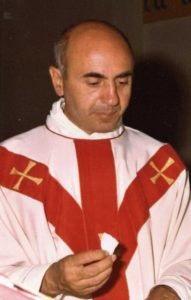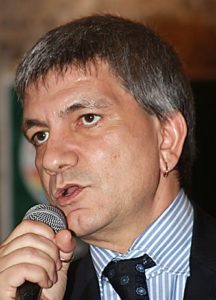The Sorrow and Reconciliation of Father Marco Bisceglia
“Hell is not intended for homosexuals, but to those who marginalize them, insult them, mock them, push them to despair and suicide.” – Fr. Marco Bisceglia, May 11, 1975. 
One of the earliest, bravest, gay Catholic activists was Fr. Marco Bisceglia. He deserves to be honored and remembered.
In 1975 Fr. Marco Bisceglia was the first Roman Catholic priest to marry two gay men. They were not a couple, but two journalists from a conservative publication looking to entrap him. Bishop Giuseppe Vairo, head of the Diocese of Venosa in southern Italy, suspended him a divinis, banning him from exercising his priesthood. The bishop had previously removed Fr. Bisceglia as pastor of Sacred Heart parish in Lavello. The bishop objected to the 50-year-old priest’s organizing and politicizing worker strikes and economic struggles. Bisceglia countered, saying the institutional church contains a “profound contradiction.” This contradiction, he says, is between a church based on an alliance with the rich and powerful and “the real message of the Gospel.” At the time of the suspension Bisceglia was not sexually active, or even out to himself. 
Marco Bisceglia traced his homosexual awareness to a dream he had when he was fifteen: “my beautiful and pure sex, love and pleasure a grace.” When he awoke, he said, “I understood that the dream was reality and reality a nightmare.” Bisceglia went into the seminary because he was convinced that he had a religious vocation. “I think that trajectory is very typical in Italy,” said a friend of Bisceglia. “A boy who prefers reading to football; a boy who doesn’t feel attracted to girls and who doesn’t understand the nature of his desires; a boy who doesn’t want to admit his thwarted desires to his family and his mother; all of that led young Italian homosexuals quite naturally to seminaries. But what was fundamental in Marco Bisceglia was that he was not a hypocrite. For several decades, while he remained in the Church, he did not experience gay life. It was only afterwards that he lived out his homosexuality with the excess of the newly converted.”
Bisceglia’s activism shifted from labor to gay rights in 1980, with the murder of a gay male couple in Giarre, a town on the east coast of Sicily. On October 31, 1980, a 25-year-old man, Giorgio Agatino Giammona, and a 15-year-old youth, Antonio Galatola, were found dead, together, each with a gunshot wound to the head. The investigations led to 12-year-old Francesco Messina as the murderer. He was Galatola’s nephew. The couple was killed by Messina on behalf of their families and with the couple’s consent. They believed they could not live without being constantly harassed and threatened, so they chose to end their lives.
Their deaths sparked the formation of Italy’s first and largest national gay group – Arcigay (Associazione LGBTI italiana) in Palermo in December 1980. Marco Biscelgia was one of the prominent founders and activists. The group became known throughout Italy for its campaign for civil unions for gay and lesbian couples. But by the time Arcigay became a nationally established organization in Bologna in 1985, Bisceglia had drifted away and traces of him were lost.
After Bisceglia came out as a gay man in 1980 he made up for his lost, chaste years. He also lived with two men; Nichi Vendola, another labor activist, and Dadi, a youth from Algeria who had immigrated to Italy. Vendola recalled a conversation he had with Biscelgia where Biscelgia bitterly regretted becoming a priest. Instead, he said, he should have spent the time becoming aware and living out his homosexuality. Vendola recalls “He re-read himself, that is, this faith and priesthood, as the result of a neurosis, of the attempt to conceal his homosexuality.” Vendola argued with him, telling him his that priesthood was an important part of him. “I told him,” Vendola said, “don’t throw Jesus into that shadow core.” Bisceglia disappeared completely shortly after that conversation. He was HIV positive. Vendola, a communist and devout Roman Catholic, became an elected representative, then leader of the southern Italian region of Apulia. 
In the early 1990s, Msgr. Luigi Di Liegro, a popular and controversial priest who was head of the Caritas for the diocese of Rome made a call to Fr. Paolo Bosetti pastor of the suburban parish of San Cleto in Rome. He asked him to accept a priest who has the “heavy burden” of AIDS. “What should we do?” asked the pastor. “Just do him good” replied Monsignor Di Liegro.
Living in the rectory with other priests, Marco Bisceglia decided he wanted to be able to celebrate Mass again. With the encouragement of Fr. Bosetti, he addressed a petition to Cardinal Joseph Ratzinger, prefect of the Congregation for the Doctrine of the Faith. The answer came a few months later: the a divinis suspension was cancelled. Bisceglia wrote to his sister, Anita, with the news: “Dear Anita, when you receive this letter I will already be reintegrated into the presbyterial service. I am fully aware of my unworthiness; how firmly I am confident in the forgiveness of God and in his purifying and regenerating action. I hope I can, with your help, repair my past mistakes and misleadings. I address you with a sincerely pacified soul and with the desire for a profound reconciliation and mutual understanding, despite the diversity of life choices.”
What were his “past mistakes and misleadings?” Bisceglia never said. He returned to the priesthood in 1996 but he never repudiated his gay rights work. When Nichi Vendola heard Bisceglia had fallen ill with AIDS he asked to see him, but Bisceglia refused. He erected a wall “between what had been and what he intended to be” and wanted to be nothing but a man “who reflects and prays and thinks and prays and lives and prays.” 
Father Marco Bisceglia celebrated his “first” Mass in the Sanctuary of Loreto in the Marche region. A delegation from the priest’s home diocese and local church arrived, led by Bishop Vincenzo Cozzi. During the service Bisceglia recited a prayer he had composed on the merciful tenderness of God. In writing those verses, perhaps he thought of what he had confided to Nichi Vendola, when he said he feared he had done everything wrong and reduced his life to a pile of rubble. “With that same rubble,” he said, “you have thus rebuilt your Sanctuary.”
Father Bisceglia died on July 22, 2001. It was a day of violent protest by leftist groups over the G8 summit meeting in Genoa. Hundreds of people were injured and arrested. Bisceglia was buried in the priests’ cemetery in Lavello. Bishop Giuseppe Vairo died three days later.

April 28th, 2020 at 1:59 am
A sad story. The poor man was a bit of a mess but certainly deserves to be remembered for his honesty and good works.